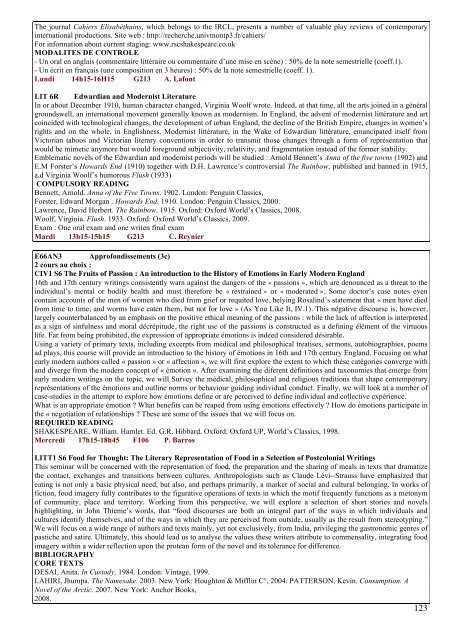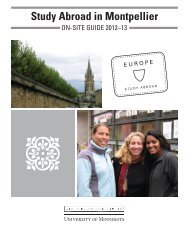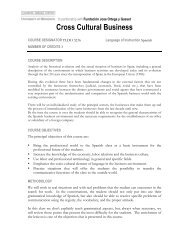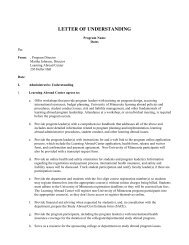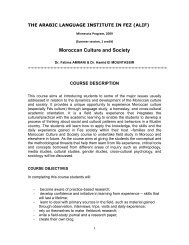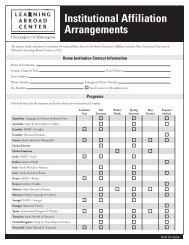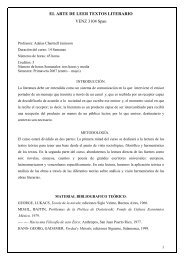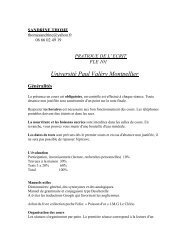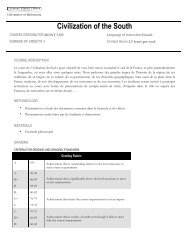04 67 79 15 42 2012-2013 SEMEST - University of Minnesota
04 67 79 15 42 2012-2013 SEMEST - University of Minnesota
04 67 79 15 42 2012-2013 SEMEST - University of Minnesota
You also want an ePaper? Increase the reach of your titles
YUMPU automatically turns print PDFs into web optimized ePapers that Google loves.
The journal Cahiers Elisabéthains, which belongs to the IRCL, presents a number <strong>of</strong> valuable play reviews <strong>of</strong> contemporary<br />
international productions. Site web : http://recherche.univmontp3.fr/cahiers/<br />
For information about current staging: www.rscshakespeare.co.uk<br />
MODALITES DE CONTROLE<br />
- Un oral en anglais (commentaire littéraire ou commentaire d’une mise en scène) : 50% de la note semestrielle (coeff.1).<br />
- Un écrit en français (une composition en 3 heures) : 50% de la note semestrielle (coeff. 1).<br />
Lundi 14h<strong>15</strong>-16H<strong>15</strong> G213 A. Lafont<br />
LIT 6R Edwardian and Modernist Literature<br />
In or about December 1910, human character changed, Virginia Woolf wrote. Indeed, at that time, all the arts joined in a général<br />
groundswell, an international movement generally known as modernism. In England, the advent <strong>of</strong> modernist littérature and art<br />
coincided with technological changes, the development <strong>of</strong> urban England, the decline <strong>of</strong> the British Empire, changes in women’s<br />
rights and on the whole, in Englishness. Modernist littérature, in the Wake <strong>of</strong> Edwardian littérature, emancipated itself from<br />
Victorian taboos and Victorian literary conventions in order to transmit those changes through a form <strong>of</strong> représentation that<br />
would be mimetic anymore but would foreground subjectivity, relativity, and fragmentation instead <strong>of</strong> the former stability.<br />
Emblematic novels <strong>of</strong> the Edwardian and modernist periods will be studied : Arnold Bennett’s Anna <strong>of</strong> the five towns (1902) and<br />
E.M Forster’s Howards End (1910) together with D.H. Lawrence’s controversial The Rainbow, published and banned in 19<strong>15</strong>,<br />
a,d Virginia Woolf’s humorous Flush (1933)<br />
COMPULSORY READING<br />
Bennett, Arnold. Anna <strong>of</strong> the Five Towns. 1902. London: Penguin Classics,<br />
Forster, Edward Morgan . Howards End. 1910. London: Penguin Classics, 2000.<br />
Lawrence, David Herbert. The Rainbow. 19<strong>15</strong>. Oxford: Oxford World’s Classics, 2008.<br />
Woolf, Virginia. Flush. 1933. Oxford: Oxford World’s Classics, 2009.<br />
Exam : One oral exam and one writen final exam<br />
Mardi 13h<strong>15</strong>-<strong>15</strong>h<strong>15</strong> G213 C. Reynier<br />
E66AN3 Appr<strong>of</strong>ondissements (3c)<br />
2 cours au choix :<br />
CIV1 S6 The Fruits <strong>of</strong> Passion : An introduction to the History <strong>of</strong> Emotions in Early Modern England <br />
16th and 17th century writings consistently warn against the dangers <strong>of</strong> the « passions », which are denounced as a threat to the<br />
individual’s mental or bodily health and must therefore be « restrained » or « moderated ». Some doctor’s case notes even<br />
contain accounts <strong>of</strong> the men <strong>of</strong> women who died from grief or requited love, belying Rosalind’s statement that « men have died<br />
from time to time, and worms have eaten them, but not for love » (As You Like It, IV.1). This négative discourse is, however,<br />
largely counterbalanced by an emphasis on the positive ethical meaning <strong>of</strong> the passions : while the lack <strong>of</strong> affection is interpreted<br />
as a sign <strong>of</strong> sinfulness and moral décrépitude, the right use <strong>of</strong> the passions is constructed as a defining élément <strong>of</strong> the virtuous<br />
life. Far from being prohibited, the expression <strong>of</strong> appropriate émotions is indeed considered désirable.<br />
Using a variety <strong>of</strong> primary texts, including excerpts from médical and philosophical treatises, sermons, autobiographies, poems<br />
ad plays, this course will provide an introduction to the history <strong>of</strong> émotions in 16th and 17th century England. Focusing on what<br />
early modern authors called « passion » or « affection », we will first explore the extent to which thèse catégories converge with<br />
and diverge from the modern concept <strong>of</strong> « émotion ». After examining the diferent définitions and taxonomies that emerge from<br />
early modern writings on the topic, we will Survey the médical, philosophical and religious traditions that shape contemporary<br />
représentations <strong>of</strong> the émotions and outline norms or behaviour guiding individual conduct. Finally, we will look at a number <strong>of</strong><br />
case-studies in the attempt to explore how émotions define or are perceived to define individual and collective expérience.<br />
What is an appropriate émotion ? What benefits can be reaped from using émotions effectively ? How do émotions participate in<br />
the « negotiation <strong>of</strong> relationships ? These are some <strong>of</strong> the issues that we will focus on.<br />
REQUIRED READING<br />
SHAKESPEARE, William. Hamlet. Ed. G.R. Hibbard. Oxford: Oxford UP, World’s Classics, 1998.<br />
Mercredi 17h<strong>15</strong>-18h45 F106 P. Barros<br />
LITT1 S6 Food for Thought: The Literary Representation <strong>of</strong> Food in a Selection <strong>of</strong> Postcolonial Writings<br />
This seminar will be concerned with the representation <strong>of</strong> food, the preparation and the sharing <strong>of</strong> meals in texts that dramatize<br />
the contact, exchanges and transitions between cultures. Anthropologists such as Claude Lévi--‐Strauss have emphasized that<br />
eating is not only a basic physical need, but also, and perhaps primarily, a marker <strong>of</strong> social and cultural belonging. In works <strong>of</strong><br />
fiction, food imagery fully contributes to the figurative operations <strong>of</strong> texts in which the motif frequently functions as a metonym<br />
<strong>of</strong> community, place and territory. Working from this perspective, we will explore a selection <strong>of</strong> short stories and novels<br />
highlighting, in John Thieme’s words, that “food discourses are both an integral part <strong>of</strong> the ways in which individuals and<br />
cultures identify themselves, and <strong>of</strong> the ways in which they are perceived from outside, usually as the result from stereotyping.”<br />
We will focus on a wide range <strong>of</strong> authors and texts mainly, yet not exclusively, from India, privileging the gastronomic genres <strong>of</strong><br />
pastiche and satire. Ultimately, this should lead us to analyse the values these writers attribute to commensality, integrating food<br />
imagery within a wider reflection upon the protean form <strong>of</strong> the novel and its tolerance for difference.<br />
BIBLIOGRAPHY<br />
CORE TEXTS<br />
DESAI, Anita. In Custody. 1984. London: Vintage, 1999.<br />
LAHIRI, Jhumpa. The Namesake. 2003. New York: Houghton & Mifflin C°, 20<strong>04</strong>. PATTERSON, Kevin. Consumption. A<br />
Novel <strong>of</strong> the Arctic. 2007. New York: Anchor Books,<br />
2008.<br />
123


